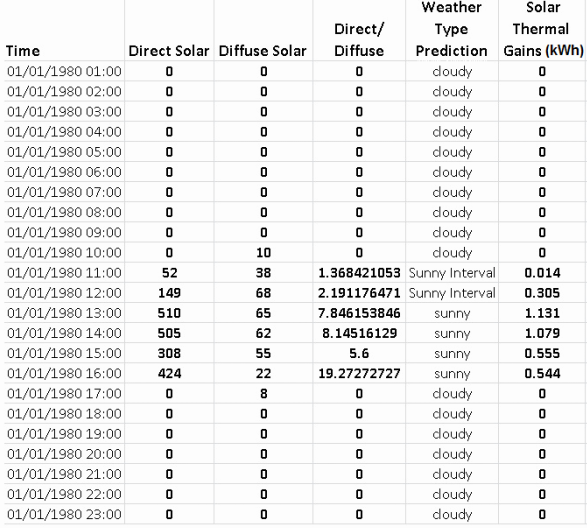Solar Thermal Forecaster
If we want to optimise our combi-system such that solar thermal contributions are maximised, how best to do this?
Now in most current configurations, the boiler either operates by simple thermostat or time controlled systems. This can be a problem in the case of solar thermal, as from the graph shows periods of demand do no correlate well with times of peak solar thermal input. Also the green line, which is the temperature in the boiler room of our case study which we used as an indicator of boiler use, shows that the boiler comes on after the surge in morning demand to top up the tank store, and what follows immediately after is a surge in solar thermal Input.To maximise use of solar thermal contributions it would be good to have a way in the morning to forecast solar thermal gains over the coming day to know if these solar thermal gains would be enough to meet demand without need for biomass boiler operation. A control system could then make use of this forecasting ability to make a decision of when and if to hold of biomass operation.
Now in most current configurations, the boiler either operates by simple thermostat or time controlled systems. This can be a problem in the case of solar thermal, as from the graph shows periods of demand do no correlate well with times of peak solar thermal input. Also the green line, which is the temperature in the boiler room of our case study which we used as an indicator of boiler use, shows that the boiler comes on after the surge in morning demand to top up the tank store, and what follows immediately after is a surge in solar thermal Input.To maximise use of solar thermal contributions it would be good to have a way in the morning to forecast solar thermal gains over the coming day to know if these solar thermal gains would be enough to meet demand without need for biomass boiler operation. A control system could then make use of this forecasting ability to make a decision of when and if to hold of biomass operation.
Figure 1. May - Average temperature in boiler room and average demand vs solar thermal output,
tool
| solarthermalforecaster.xlsx | |
| File Size: | 51 kb |
| File Type: | xlsx |
The finished tool allows a user to input their 12 hour forecast and receive a value for their expected solar thermal gains, The tool tailors the forecast to each specific month of the year and time of day to take into account changing sunrise and sunset times and other aspects that change on a month to month basis.
This would theoretically allow a control system to roughly know the expected solar thermal output for the coming day and so make informed decisions on whether or not to hold off biomass boiler operation. The Solar Thermal Forecaster works by basing its calculations around MERIT simulation software, a table of data was compiled using data from a simulation involving a south facing 3m^2 flat panel collector in Dundee.
From this table the magnitude of direct and diffuse solar was looked at and compared to the resulting solar thermal output at each specific hour throughout each month. It was then inferred from the ratio of direct to diffuse whether each hour of the day was "sunny" or with "sunny intervals" or was with "total cloud cover". From this it meant an average for the output of a solar thermal panel under these three separate weather conditions could be forecast for each hour of a specific month.
This would theoretically allow a control system to roughly know the expected solar thermal output for the coming day and so make informed decisions on whether or not to hold off biomass boiler operation. The Solar Thermal Forecaster works by basing its calculations around MERIT simulation software, a table of data was compiled using data from a simulation involving a south facing 3m^2 flat panel collector in Dundee.
From this table the magnitude of direct and diffuse solar was looked at and compared to the resulting solar thermal output at each specific hour throughout each month. It was then inferred from the ratio of direct to diffuse whether each hour of the day was "sunny" or with "sunny intervals" or was with "total cloud cover". From this it meant an average for the output of a solar thermal panel under these three separate weather conditions could be forecast for each hour of a specific month.
Figure 2. An extract from the MERIT simulation data that formed the basis of the Solar Thermal Forecaster Tool.
There will however be a number of weak points in the forecaster, the term "sunny intervals" covers a wide range of weather and as such solar thermal outputs, but it is hoped that by using averages, that over the whole of the day any inaccuracies in any one hour will be evened out. Also the ratios of diffuse to direct that would constitute a "sunny" period or a "sunny Interval" period was arrived at through guess work as their was no available data as to what the Met Office constitutes for an hour to be "sunny" etc and what the ratio of diffuse to firect would be for each weather type.


